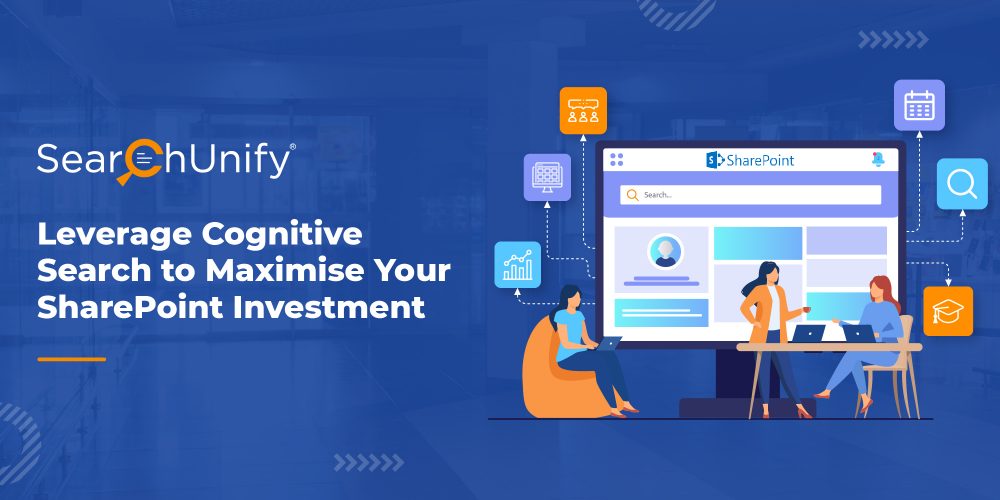
More than 190 million people across 200,000 organizations use Microsoft SharePoint for intranets, team sites and content management. Despite it being a great platform for intranets and sites, users have expressed that its search capabilities could be better. When operating within Microsoft environments, SharePoint is effective as standalone software. Otherwise, retrieving relevant results as and when needed becomes a little challenging.
In this article, we’ll walk you through the top pain points reported by users with SharePoint intranet adoption and how cognitive technology harnesses the power of AI, ML and NLP to enhance SharePoint’s capabilities.
What are the top pain points of SharePoint Search?
When SharePoint is deployed out-of-the-box, which plenty of organizations do, it more than often fails to generate desired results. Reasons include everything from confusing navigation to lack of features to incessant hours of digging around files. However, the most commonly reported paint points with SharePoint intranet are as follows:
- Auto-Indexing Capabilities: While searching for information on a SharePoint instance, you find what’s in your search index. Therefore, not finding the desired results may be a case of SharePoint not actually having the relevant content sources indexed. Although it may auto-index your content on Microsoft Office SharePoint Server (MOSS) or Windows SharePoint Services (WSS), but the scope of your enterprise content is beyond that. Irrespective of the content format, it should be indexed automatically on creation as well as on updation to ensure search relevance.
- Full-Text Search Capabilities: The search schema of SharePoint just looks for metadata and returns results without searching within the document, images, reports, etc. So when it comes to unstructured data with no metadata, retrieving anything meaningful becomes quite a task. Alternatively, if you configure your SharePoint infrastructure to enable full-text search, it may not highlight all the results within the given document. On that account, a solution that perfectly compliments SharePoint is required.
- Setting up Custom Tags: In real-world applications, we are accustomed to searching by tags or metadata – be it a hashtag on Twitter or Instagram. Tags or metadata allow users to narrow down search results to a specific field. SharePoint brings along inbuilt tags such as time and filetype whereas it disables setting up custom tags by default. You need to configure your SharePoint instance in order to add custom tags, which again is a cumbersome and confusing process. Perhaps a reason why users tend to sidestep it and put search relevance at stake.
- Personalized Search Results: Customization is the new black and SharePoint definitely doesn’t have a default option for personalized results. Therefore, leaving users unhappy and frustrated.
How Cognitive Search increases user adoption of SharePoint?
It’s worth repeating that you cannot make the most of SharePoint’s capabilities when it is deployed out-of-the-box. Combine it with an ingenious technology such as cognitive search and deliver a better and more efficient native search experience. Let’s see how cognitive tools help to fix the pain points discussed above.
- Unified Indexing: As aforementioned, SharePoint is effective when operating within Microsoft environments. However, your organization needs a lot more to provide the next-gen search experience. Cognitive technology brings along a robust indexing engine, whose crawler goes beyond MOSS or WSS; giving a unified, 360-degree view of the entire enterprise knowledge base.
- Automatic Taxonomy Construction: As per a report by IDC, 80% of worldwide data will be unstructured by 2025. Therefore, the need of the hour is a scalable solution that compliments SharePoint and is capable of retrieving relevant results as and when required. A cognitive search engine is exactly what we are looking for. It extracts entities and enriches content to make it more meaningful. It identifies and classifies key elements from unstructured data to auto-categorize them and make them SEO-friendly.
- Personalized Search Relevance: Cognitive search engines leverage Natural Language Processing (NLP) that plays a significant role in uncovering users’ behavioral patterns. Furthermore, it taps into historical data to produce results that are not just limited to keywords entered in the search-box, instead results reflect the context of the query and the user intent. The better the understanding of user intent, the more relevant are the results.
- Search Tuning: Cognitive search tools deliver the most relevant search experience without compromising on the industry security standards. By leveraging AI and ML, they make real-time decisions to auto-tune search results and customize user interface. They also provide you with an option to manually tune your search results in order to cut down on the number of clicks to access the right collateral.
- Search Analytics: No matter how hard you try, content gaps are bound to crop up over time. After all, changing user behavior is the only constant. The search analytics of cognitive technology gives you insight into user behavior and content usability. By optimally utilizing the data gathered by AI-powered insight engines, you can fill the content gaps to make your intranet portal the go-to place for all your employees.
Want to Optimize Intranet Adoption with Cognitive Technology?
While intranet continues to become more sophisticated, the search experience has been forsaken for far too long. Cognitive search fits the bill to overcome the challenges that get in the way of native search. Download our free eBook for a comprehensive guide on how cognitive technology powers successful intranet adoption.











